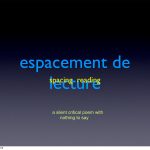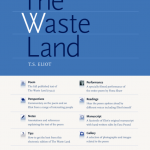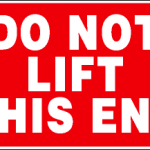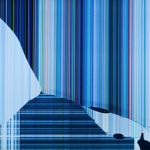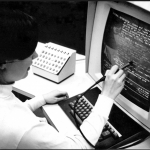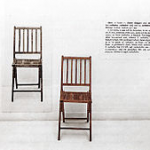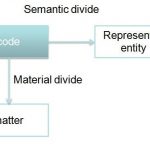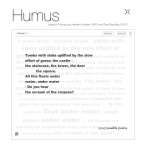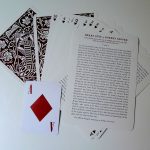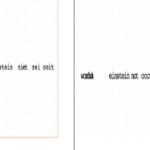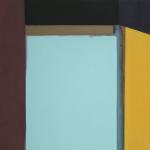2013
According to Janez Strehovec, e-literature operates on the model of post-Fordist immaterial production. He argues it's precisely because "a part of contemporary art (especially the new media one and e-literature) is crossing into the service sector of (new) networked economy in the post-industrial, information, spectacle- and software society" that e-literature needs to cultivate its own autonomous context.
This introduction is not a "digital" essay, but what follows it - a version of a moving essay-poem originally presented in real time at the 2012 elo conference - is. Florence's presentation explores how the "espacement" (Mallarme, Derrida) intrinsic to all writing changes in a born-digital context. The work reminds us of something we anticipated early in the formation of ebr - that 'critifiction' is and always has been the way to make essays in the digital era.
"At the Time of Writing" considers the role of proprioception and the embodied memory of writing and gesture as a critical component of readerly practices. Anna Gibbs and Maria Angel examine a series of works of born digital literature that use representational techniques to evoke an "ethos of touch" that is critical to the experience of the work. Gibbs and Angel conclude that feeling is key to the process of meaning-making, and that experimental interfaces foreground the importance of the body in literature.
Type enough questions, Lisa Swanstrom suggests, and "Galatea" answers Socrates' ancient call for a poetry that talks back. Using Emily Short's interactive fiction as a model, Swanstrom argues that the khora - the strange Platonic intermediary between form and copy - might serve as a guide for understanding the peculiar nature of literary interactivity itself.
Andrew Klobucar argues that a new iPad app for The Waste Land demonstrates, despite the developer's intentions and Eliot's fears, that the symbolic form of the database is irrepressible. According to Klobucar, Eliot bemoans the cultural impact of new media and technological innovation, though his poem--particularly through Pound's editorial notes and Eliot's added annotations--employs the structure of a database. The app for The Waste Land attempts to mitigate this tension by promoting a sing...
Taking recent writings-of-internet as test cases, Stuart Moulthrop demonstrates the folly of deploying modernist compositional models, even avant-garde theories of citational and conceptual poetry recently popularized by Kenneth Goldsmith and the Flarf poets, to read born-digital writing. Though it may be fun, it's ultimately futile to interpret the contingent output of an "interface in process" as a poem existing in a fixed, terminable state. Perhaps, then, interfacing with databases is becoming integral to not just electronic literature and digital poetics but all forms of literary study and practice?
In this essay, Davin Heckman argues that works of electronic literature often provide occasions for cultivating attention in a mutable cultural landscape. Through readings of John Cayley, YHCHI, Rob Wittig, and Richard Holeton, Heckman points to a poetics of technical estrangement by which new media is opened up to deliberative reading, and thus presents contemporary readers with the opportunity to develop critical practices appropriate for the conditions of neoliberalism.
2012
Florian Cramer's essay reframes debates on electronic literature within larger cultural developments in writing and publishing. On the one hand, he shows the commitment of the field of electronic literature - as found in universities or in organizations such as the ELO - to a "literary" intermedia writing for electronic (display) media. On the other hand, he emphasizes a wide-ranging post-digital poetics defined by a DIY media practice rather than the choice of a particular medium, a poetics which is broadly orientated towards writing rather than literature. At stake in this opposition is the larger question of literary studies in a world of creative digital industries.
Jhave's wide-ranging history and prospectus alerts us to cognitive, material, and mythic dimensions of the nexus of image and text. By showing how text evolved into image, the essay traces a new malleability, dimensionality, and embodiment of writing. The contemporary image-text is a quasi-object with experimental literary qualities as well as an almost organic media dynamism.
Serge Bouchardon and Davin Heckman put the digit back into the digital by emphasizing touch and manipulation as basic to in digital literature. The digital literary work unites figure, grasp, and memory. Bouchardon and Heckman show that digital literature employs a rhetoric of grasping. It figures interaction and cognition through touch and manipulation. For Bouchardon and Heckman, figure and grasp lead to problems of memory - how do we archive touch and manipulation? - requiring renewed efforts on the part of digital literary writers and scholars.
Yra van Dijk calls for a return to the text, for a criticism of digital literature that moves past foundational work on the new form and seriously engages with the work itself. In Roberto Simanowski's Digital Art and Meaning and in the edited collection Reading Moving Letters, van Dijk finds a return engagement with deep meaning and with criticism as a site of intentional human experience, and not of heavy theory or machinic spectacle.
Rui Torres tracks the practice of intertextual borrowing or "plagiotropia" between the works of Portuguese experimental poets. Plagiotropia is a tangible and fecund practice in digital poetry, where poetic texts migrate and grow across media. Torres' arguments culminate in an examination of his own online combinatory cyber-poetry, which creatively re-writes earlier pre-digital experimental works.
Zuzana Husárová and Nick Montfort up the ante for experimental writing by examining the category of "shuffle literature." What is shuffle literature? Simply put: books that are meant to be shuffled. Using formal reading of narrative and themes, but also a material reading of construction and production, Husárová and Montfort show that there are many writing practices and readerly strategies associated with this diverse category of literature.
In this riposte, Marie-Laure Ryan suggests Lisa Swanstrom has 'flattened' the dimensions of her arguments about digital narrative as well as the dimensions of the digital experience itself.
2011
In an increasingly monolingual, globalized world, the second volume of the Electronic Literature Collection may just offer a map of the territory. The question the reviewer, John Zuern, poses is how do we navigate this terrain going forward?
Just when you thought you were used to electronic literature, this critic makes the case for "beyond the screen" with a review of Jörgen Schäfer and Peter Gendolla's book of the same title, focusing on "transformations of literary structures, interfaces and genre."
Stuart Moulthrop uses the lessons of hypertext as both an analogy and an explanation for why hypertext and its criticism will stay in a "niche" - and why, despite Bell's concern, that's not such a bad thing. As the response of an author to his critic, addressed to "thee," "implicitly dragging her into the niche with me," this review also dramatizes the very productivity of such specialized, nodal encounters.
2010
In this piece - part introduction, part artist's statement - Whitney Anne Trettien reflects on her "combinatory" approach to the history of "text-generating mechanisms."
Kate Pullinger thinks the Digital Fiction International Network is too hasty in dismissing e-books as "paper-under-glass texts."
An international group of digital fiction scholars proposes a platform of critical principles, seeking to build the foundation for a truly "digital" approach to literary study.
